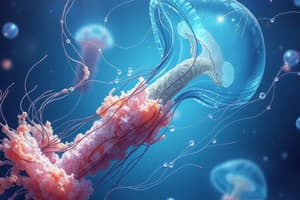Podcast
Questions and Answers
What is the body structure of jellyfish?
What is the body structure of jellyfish?
Soft body with a hollow central cavity filled with mesoglea, tentacles with nematocysts, and two tissue layers.
Jellyfish have only one tissue layer.
Jellyfish have only one tissue layer.
False (B)
Which of the following statements about jellyfish is true? (Select all that apply)
Which of the following statements about jellyfish is true? (Select all that apply)
- Dead jellyfish cannot sting.
- Nematocysts can replace themselves in 48 hours. (correct)
- Jellyfish have a complex body structure with bones.
- Jellyfish have separate sexes. (correct)
What are the types of jellyfish mentioned?
What are the types of jellyfish mentioned?
Is the Portuguese Man-Of-War a true jellyfish?
Is the Portuguese Man-Of-War a true jellyfish?
What is the most common jellyfish?
What is the most common jellyfish?
What do Sea Anemones resemble when their tentacles are extended?
What do Sea Anemones resemble when their tentacles are extended?
Flashcards are hidden until you start studying
Study Notes
Body Structure of Cnidaria Class Scyphozoa
- Soft body consists of a hollow central cavity filled with mesoglea, a jelly-like material.
- Tentacles equipped with nematocysts are utilized for capturing small prey.
- Some jellyfish possess painful stings, and discharged nematocysts can regenerate in 48 hours.
- Dead jellyfish retain the ability to sting due to remaining stinging cells.
- Jellyfish exhibit separate sexes.
- Body structure comprises only two tissue layers.
Life Cycle of a Jellyfish
- Life cycle characteristics not provided.
Types of Jellyfish
- Includes notable species such as:
- Portuguese Man-Of-War (Physalia): A colonial organism, not a true jellyfish.
- Moon Jellyfish (Aurelia): The most prevalent species.
- Sea Anemones: Related marine entities, often mistaken for jellyfish due to appearance.
Portuguese Man-Of-War (Physalia)
- Classified as a colonial organism, consisting of multiple interconnected individuals.
- Tentacles can extend up to 60 feet long, displaying a bluish color.
Moon Jellyfish (Aurelia)
- Recognized as the most common jellyfish species found in various marine habitats.
- Generally considered relatively harmless to humans.
- Primarily feeds on copepods, small crustaceans integral to aquatic ecosystems.
Sea Anemones
- Extend tentacles resembling flower petals during display.
- Closed tentacles may resemble a doorknob shape when retracted.
- Possess powerful stings due to nematocysts, serving both defense and prey capture.
- Display a broad spectrum of colors, enhancing their visual appeal in marine environments.
Studying That Suits You
Use AI to generate personalized quizzes and flashcards to suit your learning preferences.




